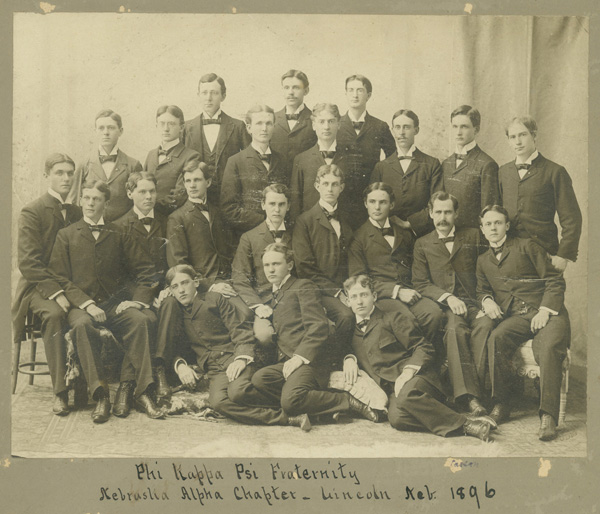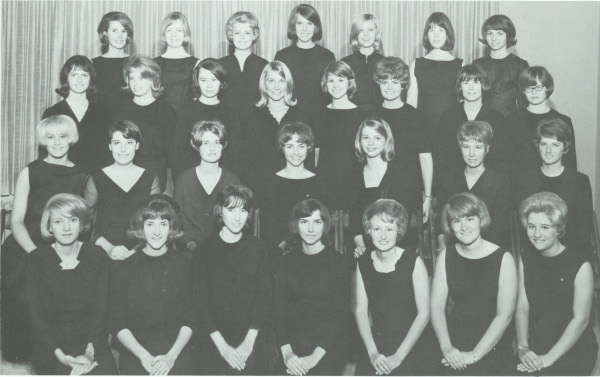Projects
Greek Life at the University of NebraskaProject Editor: J.V. Dorsey, UCARE, 2008
On September 15, 1871, a group of twenty-five students petitioned
and were allowed to form the first student organization. They were given
a room in University Hall provided that the nine-thirty curfew was not
broken on their Friday night meetings. Thus the literary society, The
Palladian Society, was born and became an instant attraction to college life.
Entertainment was scarce in the 1870's, so sometimes townspeople, faculty
and even the chancellor attended meetings. More societies formed and
these new societies provided an excellent environment for social growth.
A lot of students regarded the group as one of the best things about
the college experience.
In the 1880's fraternities made their appearance at the University
and the social power structure of the campus began to change.
Fraternities were organizations of men living together. In January of 1883, the
Alpha Epsilon chapter of Sigma Chi Fraternity was established and became
the first stable (Phi Delta Theta was the first ever) fraternity at
the University. Kappa Kappa Gamma became the first "female fraternity" or
sorority in 1884. Following these first organizations were a host of
Greek fraternities that are still on campus today. Members of
fraternities of the time were more concerned about cheap living quarters than
they were about socializing. Greek houses were less expensive than dorms
or apartments and thus became popular. With the quick sprouting of Greek
organizations came conflicts with the literary societies who were
losing members and influence to the Greeks.

The opposition (and non Greeks) were called "barbarians" and by the
mid 1880's the war between them had begun. In the "frat fight of 1884"
the Palladian's revised their constitution to exclude fraternity
members. As a result, a large number of people withdrew and formed their own
societies. The Hesperian (the student newspaper), was controlled by the
"barbs" and continually slashed fraternities. The paper claimed that
fraternities were composed of wealthy people who had to have their
friends selected for them. By 1900, eleven fraternities and five sororities
were established and on campus and the literary societies were losing
ground. Greek members began to find that there houses provided a home
away from home and helped make college much more enjoyable.
As the social agendas of the Greek organizations began to grow, so
did the concern for Greek scholarship. The Board of Regents worried that
people were coming to the University to experience Greek life instead
of concentrating on their studies. As a result of these concerns, the
Intra-Fraternity Council was formed in 1905 and the Intra-Sorority
Council in 1906 to regulate Greek activities. This pattern of concern for
academics continued throughout the history and development of the Greek
system.
In the 1920's the University grew to over 10,000 students. The
population explosion created a housing shortage and stimulated growth among
the Greek chapters. By the fall of 1926 nine new Greek houses were
added to campus. Now, the Greeks clearly dominated the social scene on
campus. University parties that were once extremely popular were now
occupied by only naïve freshmen, while fraternities and sororities offered
formals, parties and exchanges. As the social scene picked up,
scholarship went down and citizens began to complain that more students were
smoking, doing the two step and more girls were wearing rouge.
The depression in the 1930's and the World War in the 1940's had an
impact on the Greek system. The war seemed to boost fraternity
interest; in 1941, 272 men pledged fraternities and in 1942, 470 pledged.
Fraternity membership provided support, comfort and contributed to the
enjoyment of college life for young men facing the uncertainties of war.
Nine fraternities closed down, and the last ten struggled during the war.
In 1946, all but one reopened again with a fresh attitude. The men were
returning from the war older and more mature.

New dorms built in the 1950's took away from Greek interest. The
dorms offered better accommodations compared to the Greek houses. Also,
fraternities were being criticized for racially restrictive membership
and bad initiation practices. This caused new rules and motivation from
the Intra-Fraternity council and the Greek system began to improve and
polish all aspects of university life.
Since the 1950s, the Greek system at Nebraska has grown in size and
presence. Now the Greek system at the University of Nebraska-Lincoln is
one of the biggest in the nation with thirty fraternities, fourteen
sororities and fifteen percent of the university population.
| 
